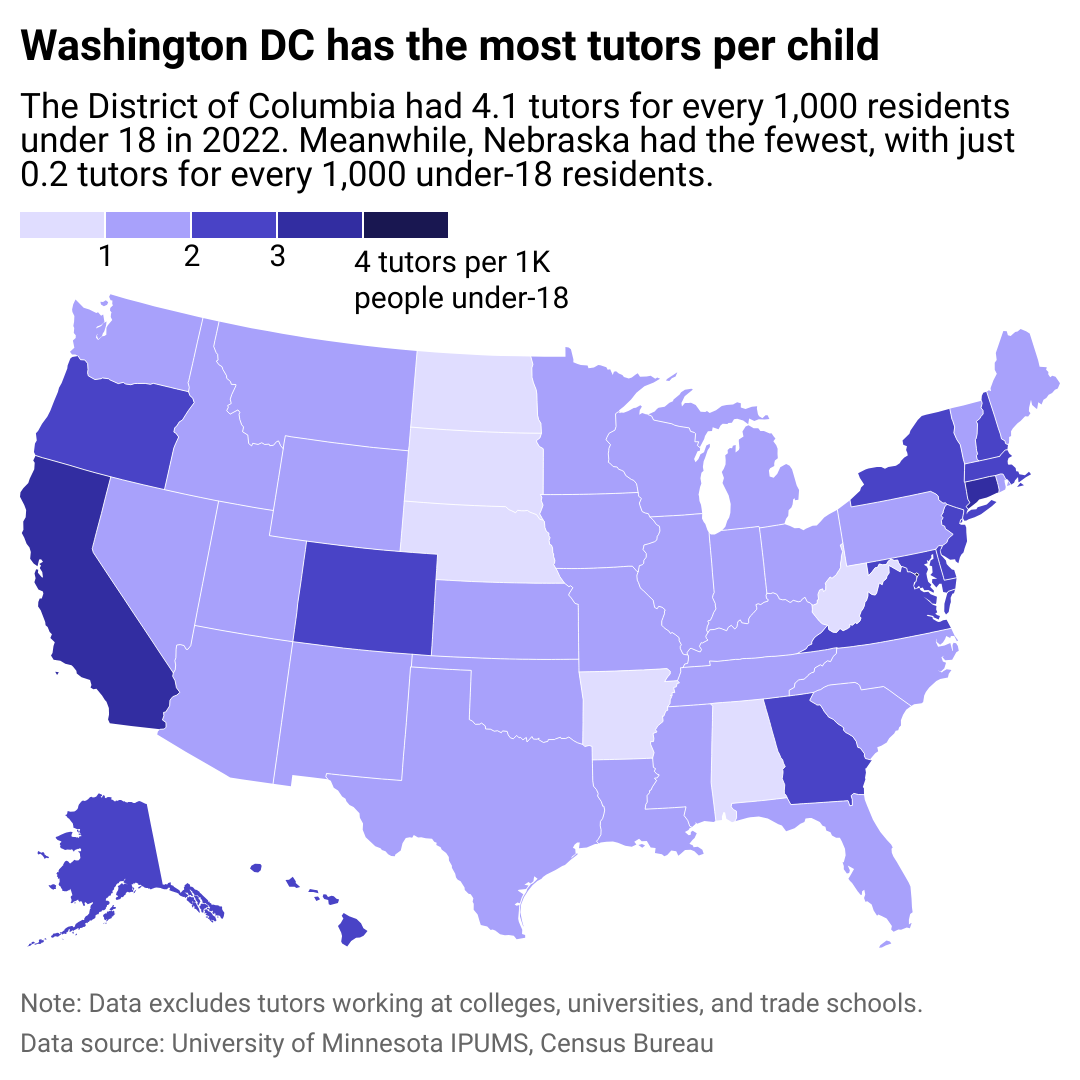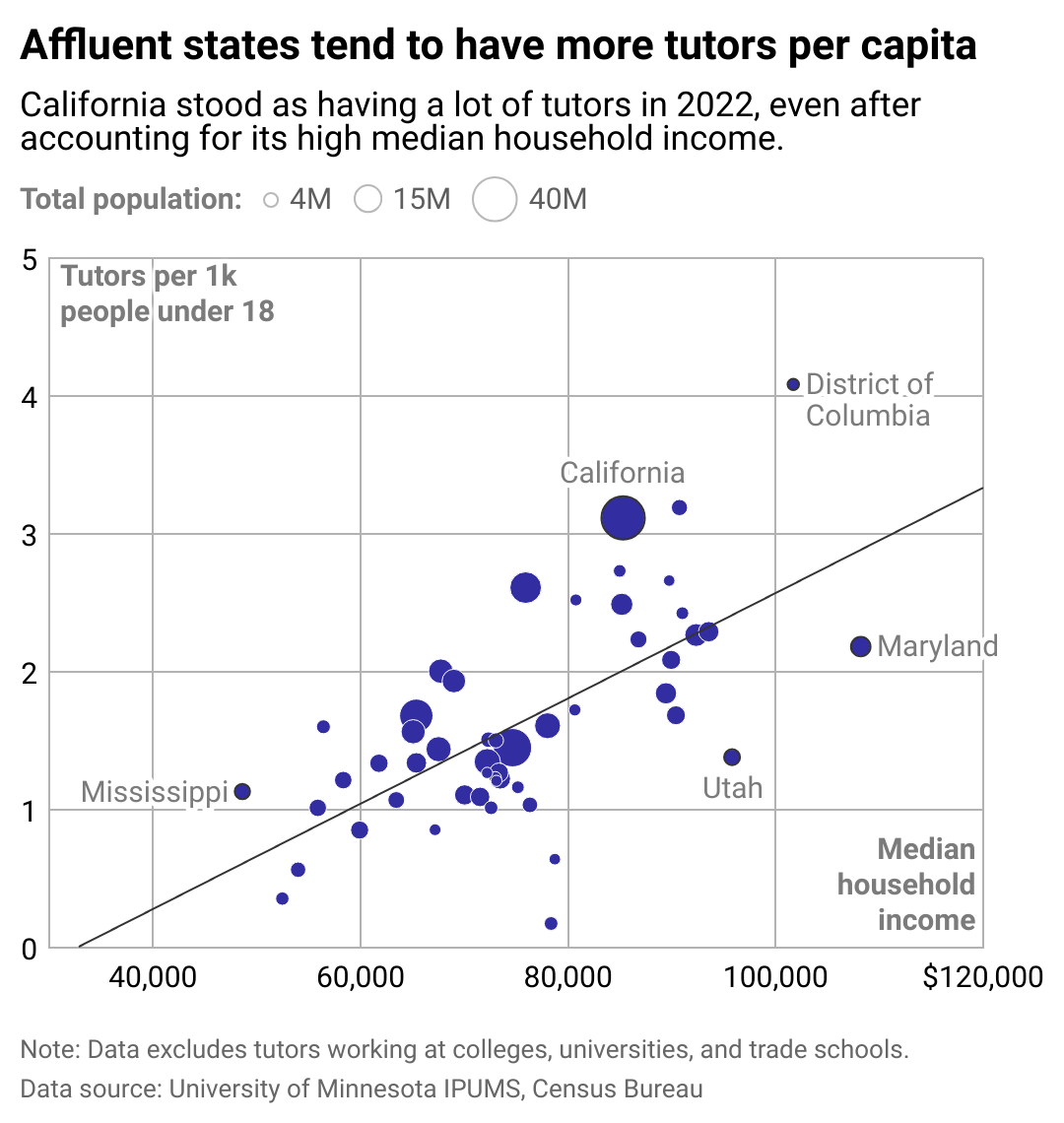
22 Apr States with the most tutors

Canva
States with the most tutors
Written by Natalie P. McNeal, Data Work by Wade Zhou
Flush with billions in COVID-19 federal relief funds, states in recent years have turned to tutoring in an effort to diminish the effects of the pandemic’s education disruption.
HeyTutor used data from the Census Bureau and the University of Minnesota’s IPUMS database to find out which states had the most tutors for every 1,000 residents under 18.
Thirty-seven percent of public schools offered high-dose tutoring, according to a federal survey released in December 2022. About 3 in 5 (59%) had standard tutoring, and 1 in 5 (21%) offered self-paced tutoring.
High-dose, or high-impact, tutoring is an intense practice following a recipe of highly trained tutors who help students for three to five sessions per week during the school day. Lessons are integrated with classroom instruction and include content that supports the classroom material. The tutoring sessions are 1-to-1 or in groups with fewer than four students.
A properly structured tutoring program can accelerate students’ math and reading competency by “five months of learning beyond students’ ordinary progress,” per the Thomas B. Fordham Institute.
Studies have shown that students with tutors can advance from the 50th percentile to nearly the 66th percentile in testing, according to the Massachusetts Institute of Technology’s Abdul Latif Jameel Poverty Action Lab.
As of November 2023, 16 states had either created or were pursuing policies related to tutoring; 40 states had allocated funding for tutoring programs; 26 states required the tutoring programs to be high impact; and 11 states had forged partnerships with higher-education institutions to help implement tutoring, according to the National Student Support Accelerator, a Stanford University nonprofit that supports high-impact tutoring.

HeyTutor
DC tops the tutor list
Washington D.C. was included in our dataset and came out on top, with 4.1 tutors for every resident under 18. Following D.C. were Connecticut (3.2 tutors) and California (3.1 tutors). At the bottom of the list were Arkansas (0.6 tutors), West Virginia (0.4 tutors), and Nebraska (0.2 tutors).
In 2022, Washington Mayor Muriel Bowser’s administration expanded the district’s tutoring efforts by launching a three-year high-impact tutoring initiative. At least $40 million is going into the program, which the district projects will exceed the goal of 10,000 students (around 10% of the student population) by the end of fiscal year 2024. The program has a focus on at-risk students.
California’s tutor population is also likely to grow. In early February 2024, the state settled a lawsuit, Cayla J. v. California, brought by families in Los Angeles and Oakland who said their kids fell badly behind during the remote schooling period. The suit maintained that students from low-income households and students of color were disproportionately hurt by remote learning during the pandemic. The settlement requires the state to spend $2 billion in leftover COVID-19 funds on tutors and other catch-up tools.
Tutoring is also making headlines in states with smaller tutor corps. In late 2022, Omaha Public Schools announced expanded tutoring in a three-part strategy that included school-based tutoring, community-based tutoring for students in before- and after-school programs, and online services.
In Arkansas, to increase the number of tutors available, the state used $4.4 million in federal funding to launch the Arkansas Tutoring Corps to train and locate capable tutors. As of October 2022, the program had 771 tutors. Arkansas has provided funding for high-dose tutoring, according to Stanford’s National Student Support Accelerator report. Not all states do.

HeyTutor
With more wealth comes more tutors
The use of private tutoring skews toward wealthier families in the U.S. Only 8% of low-income families hired a tutor to help their school-age kids, while about 19% of upper-income families hired educational help for their children, according to a 2020 Pew Research Center report.
On the public side, the lack of students accessing tutoring programs is a national concern. In Philadelphia, for instance, fewer than 1% of students eligible for district tutoring were using it in 2023.
Citing programs in Chicago; Baltimore; and Greensboro, North Carolina, the Biden administration urged states, districts, and schools to adopt high-dosage tutoring as one of three key strategies in its Improving Student Achievement Agenda for 2024.
Story editing by Mary Reardon and Ashleigh Graf. Copy editing by Paris Close. Photo selection by Lacy Kerrick.
